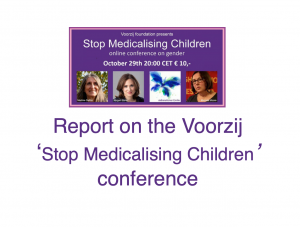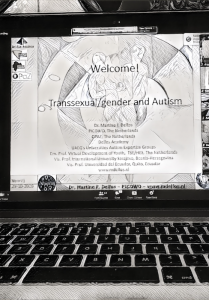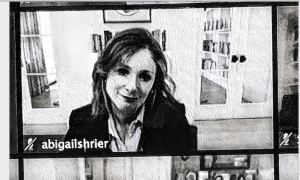
It’s been months since I went to a proper event. Obviously chat room conferences are no replacement for IRL meetings but when I saw the ‘Stop Medicalising Children’ conference advertised on Facebook I thought I’d sign up. After all, if it hadn’t been for COVID it would have been taking place in Holland. I’m up for a weekend in Amsterdam as much as the next person, but it’s unlikely I would have made my way out to Holland for a meeting. At just ten euros a ticket the cost was much the same as a slice of chocolate cake from Boerejongens, so I signed up a few days in advance and when 6.50pm on the 29th came around I left middle-child and smallest carving pumpkins in the garden, armed myself with a diet Pepsi, logged into Zoom and waited to be admitted to the meeting room.

Like most people over thirty, I was unfamiliar with Zoom before lockdown. Now I consider myself a veteran. A backdrop of rolling oceans and palm trees? Sorted. That filter that makes you look a bit less like you were up half the night? Sorted. I’ve attended parents’ evenings, celebrated family birthdays, indulged in murder mystery role plays and, of course, taken part in numerous quizzes. Sharing an impossible ‘guess the object’ quiz that I’ve knocked up in ‘Comic Life’? No problem.
So I thought I was a Zoom guru, but I was wrong. This conference was the first time I would be placed in a ‘break-out room’: a sub-group of the main conference, where smaller groups can hold a discussion and then return to the main meeting. (A break-out room is not to be confused with an Escape Room, the latter being an inexplicably popular and sometimes terrifying form of theatrical entertainment.)
At two minutes past seven I was admitted to the meeting, along with 97 others, predominantly women. Our faces were spread over four screens, and, scrolling quickly through before we started, I spotted a handful of friends and acquaintances. During the conference a ‘chat bar’ ran up the side of the screen, where discussions could take place and attendees could pose questions for the speakers.
Our host, Caroline, spoke to us with good-humour and enthusiasm, in clear second-language English, from in front of a spectacular display of what appeared to be delicate china and glass ornaments. Underneath her were the words ‘Stichting Voorzji’. I speak absolutely no Dutch beyond ‘ik ben een vegetariër’ and ‘waar is de koffieshop alstublieft ‘ so I initially thought this was her name. Retrospectively it seems more likely to be the name of the group that organised the conference: a ‘stichting’, so Google tells me, is a foundation.
Martine Delfos
The first speaker was biopsychologist and author Martine F Delfos.
Acknowledging that it was a challenge to speak on the two subjects of autism and transsexualism at the same time, Delfos began by speaking of the ‘bed nucleus of the stria terminalis’. It sounds like a great name for a goth band but is ostensibly an area of in the brain which ‘shows which identity you have or feel’. This nucleus, Delfos purports, can tell us if someone is “a heterosexual man, a heterosexual woman, a homosexual man or a transsexual woman in the body of a man”.
This somewhat surreal concept is further compounded by the drawback that it can only be observed posthumously, due to “a substance which is added to brain cells on death.”
“What does that mean?” she asked, rhetorically, and I asked myself the same question. Does it not detect lesbians? Do bisexual people confuse it? What planet will it be leaving for once all this data is gathered?
 Autism is extreme male spectrum,” she claimed. “Girls with autism are leaning to the male side.”
Autism is extreme male spectrum,” she claimed. “Girls with autism are leaning to the male side.”
Had I been attending an IRL conference I would have sensed a wave of dissent envelop the room and discretely nudged the woman next to me. Instead my WhatsApp pinged and I glanced at my phone.
“I think some lesbian ASD rad fems are getting pissed off,” read the message.
Ping again.
“I’d be so mad if I was told I had a male brain!” read a second.
It seems I wasn’t the only one having trouble with Delfos’ theories.
Suddenly there was a technical issue with the sound. An echo was overlaid on Delfos’s voice which put me in mind of the Soup Dragon from the Clangers. “There’s a real sound problem, real sound problem, problem, problem… I hear kind of music music… echo echo… I cannot speak speak speak.” For a brief moment I was flung back in time to 90s rave culture. The issue resolved, I pulled myself back to 2020 and tried to focus on what Delfos was saying.
Autism theory is changing, claimed Delfos, who has been working on a new theory for the past 20 years and believes that current theories are no longer valid. The most challenging problem for autistic people, she says, is that those around them think they understand their issues and take over their lives. “It is like living in a psychological war zone.”
Delfos believes there is no specific area of the brain that is different in people with autism, rather it is the whole brain that is different. She discussed the differences between cognition and social development and accelerated, delayed and normal development. Evidently, both the Dutch and the Maltese governments have shown interest in Delfos’ theories and I wish them much luck with them. Perhaps it was the language difference, her accent or my lack of knowledge on the subject but I have to admit it was all going straight over the top of my head and I had trouble understanding the connection between her theories on autism and trans-identification in young women, which was barely touched upon.
“We do not need to understand everything. If we only understand that we do not understand we will treat the other with more respect,” she concluded. So that’s a relief.
Delfos explains her theories in more detail in her book Unravelling Autism and you can visit her website here.
Abigail Shrier

I’m far more familiar with the work of journalist Abigail Shrier, having read her recent book ‘Irreversible Damage‘ and followed her on Twitter for some time. There are no doubt many areas of politics on which Shrier and I would agree to differ, but to my attuned mind she was far easier to understand. This may be in part, of course, to the fact that while we are divided by The Pond, we share a common first language.
Abigail’s book explores the question of why so many girls are suddenly identifying as transgender: the spikes are high and seem to be only getting higher. Like Littman, she acknowledges the power of peer to peer contagion and internet influence. Science is seen as less important than political correctness and political correctness will not allow us to have the important conversations that are needed about these matters. The fact that we are not permitted to discuss these issues, she believes, is one of the main reasons why hormones and surgery have become so easily accessible for young women.
“We’ve been convinced that it’s much nicer to engage in lies. That it’s kinder to accept the vocabulary of people who say they are in pain.” continues Shrier, pointing out that despite puberty blockers being so much more complex than simply a ‘pause button’ for puberty, that is the language that has been adopted.
“Private kindness is important,” advocates Shrier, “but public objectivity is essential. Which means when we talk in public spaces about transgender adults who say they are women, we cannot pretend that they actually are. We think it’s a nice harmless lie we’re engaging in, to protect their feelings, but it commits us to things like losing the ability to oppose biological men entering women’s safe spaces. We surrender that as soon as we enter a world of lies in the public sphere.”
0.01% of males and 0.003% of females used to be afflicted by gender dysphoria. Now, for example, 2% of high school students in America identify as trans, and around 25% of American teens identify as some form of LGBTQ. Between 2016-17 the number of gender surgeries on girls quadrupled and the number of ‘gender clinics’ has multiplied from 2 to 50. Yet doctors and therapists are afraid to speak out with their concerns.
Shrier is quick to affirm that “there are so many lovely and sober and wise transgender people” who do not support this push to transition teenage girls. She likens trans identification to anorexia and other social contagions and asserts that the risks associated with transition need to be explored.
Whilst not suggesting that people should put their jobs or families at risk, Abigail believes it’s important not to parrot lies in the public sphere, asserting that it should be ok for people not to share each others beliefs. The issue is not about feelings but about medical interventions. We need to be able to question whether these young dysphoric women are being harmed or helped by ‘major medical interventions with irreversible consequences’.
She spoke of the efforts to censor her and how parents had crowdfunded to pay for an unsolicited but appreciated bill board in Los Angeles promoting her book.
“For my next book, I think I’ll take on a different topic,” she said, with a wry smile, when asked.
When asked about the effect of the book on the way she is perceived, Shrier says she ‘gets a lot of pushback’ but doesn’t like to dwell on it too much, “because I don’t like anyone to get the false impression that they can intimidate me.”
Michele Moore

Michele started by saying she was also concerned with the pushback faced by those who share their concerns about the issues of transgendering children and young people. Like Abigail she tries not to find it intimidating. She spoke of how the Tavistock and Portland Trust had tried to block the publication of her second book, Inventing Transgender Children and Young People, despite it containing pieces by the leading commentators in the world.
Moore believes that she may well lose her job for speaking out against the transgendering of children due to the numerous campaigns of public shaming. She had only been in her new job a few days before people began writing to her employers claiming she was a ‘hate speaker’ and ‘making crushing demands to silence me’. Despite her job and reputation being under threat she decided to speak tonight. ‘I will not trade my silence for survival’ she says firmly, adding that she hopes to give others the courage to speak out in the future. Academics, she says, are afraid of being caught ‘not applauding’ by the ‘self-appointed petitioners of righteousness’ who feel that only their world view should be tolerated.
“What is our transgression?” she asks. “That we call for evidence on the safety of gender intervention for children and young people. We call for public debate on why children and young people are being told they can change sex when they can’t.”
Moore believes that asking questions about experiments on the minds and bodies of children is essential, even if there is a personal cost. Children and families must not be sold a lie.
“All psychological and medical interventions on children should be subject to medical, ethical, scientific and public scrutiny, with the principle of ‘first do no harm’ right at the front of our thinking.”
Moore accepts that gender dysphoria is real and some children suffer deeply. Experimental interventions are a superficial response to what is often “a maladaptive coping mechanism to distress or trauma” and she points out that most trans-identified children go on to change their minds. She professes that she will continue to petition to keep the conversation open surrounding the importance of robust, evidence-based, treatments. Moore points out that the case of Keira Bell precisely illustrates the dangers of accepting a young person’s self-diagnosis of being transgender.
“It is clear to me, from listening to people who have been through transitioning, that gender medicine actually deepens gender dissatisfaction, and of course, it won’t ever change a person’s biological sex…
…I say again, I will not trade my silence for survival and I ask everybody who is listening tonight, each one try to speak; each one try to teach one. We must push the boundaries of the work that we’re doing here.”
Emilie
The final speaker was Emilie, a detransitioner. This conference was the first time she had used her real first name to speak in public. Emilie was introduced to the idea of gender identity when she was 19. She was diagnosed at 21 and had a double mastectomy and started hormones before detransitioning at 23. She identified as trans for four years.
A stereotypical ‘tomboy’ as a child, Emilie felt confident being a ‘tough girl’. It wasn’t until she started high school that she became self-critical about her difference to ‘most other girls’. Feeling pressure to wear make-up and dresses, she tried to conform for several years but never felt comfortable performing femininity. After leaving school her mental health declined and she made a new friend who told her that her feelings were due to discomfort with her gender identity. Spending a lot of time on the internet and watching YouTube videos on the subject, she felt that her discomfort was explained by gender identity theory. Cutting her hair and wearing boyish clothes felt good and she initially identified as non-binary, thinking that people would be able to understand her better. The opposite happened; she continued to feel alienated from the world around her and began to blame her body. Over a period of about 18 months she went from not wanting to modify her body to desiring a diagnosis. After a year long process she became more and more certain that transiiton was the answer for her. After diagnosis she had a double mastectomy which she said felt like ‘a huge relief’.
“I was extremely happy when I woke up from the surgery. At that moment it felt like ‘Finally! Finally I’m doing something about this issue that has been bothering me for the last three years and it’s gonna turn out fine.'”
Shortly after that she started on hormones. Most detransitioners, she says, don’t come to the decision to detransition as quickly as she did. She met a fellow FtM, fifteen years older than her, and they gradually became close. She had expected to be encouraged on the trans path by this friend, but they told her not to have too high expectations of transition, to expect problems with health issues and not to expect all her dysphoria, anxiety or depression to resolve.
Emilie began looking up the science behind transition. She was shocked to find a study from Birmingham which suggested it wasn’t possible to prove that medical transition was an efficient treatment. She also found a Swedish study, one of the few long term studies, which shows that although some dysphoria is helped by treatment, mental health doesn’t necessarily improve and the suicide rate post transition is still ‘super high’.
“You just expect- you assume- it’s a proven method, a proven treatment or someone would have warned you.”
Feeling trapped, four years ‘out’ as transgender, Emilie stopped taking hormones. She found videos on YouTube by detransitioned women, which showed her that there are other ways to understand dysphoria and why you might find it hard to call yourself a woman. She spent a month ‘laying on the sofa and absorbing everything I could find on the internet’. Understanding the issue from a radical feminist point of view also helped her find empowerment. It was a very stressful time, and she decided to move to the other side of the country rather than explain her situation to her friends in the trans community.
This was three years ago.“I’m doing much, much better,” she says, ” I’m really thankful that I discovered all this new information and this change of perspective.”
She felt that those who knew her would have said, “Emilie is definitely the one who is going to be ‘true transgender’.”
“I was very certain from the start. I was as sure as I could be. It was the new information that changed my path… I feel that I was lucky that I was able to detransition. I was 23 years old, I had that ability to just move to another city but it really required a lot of strength. There’s so much shame involved: leaving the trans community and trying to explain, it’s a huge thing to do. I’m really concerned about young people who are a bit uncertain but are stuck in that situation and don’t know how to get out of it.”
Questions and the ‘break out’ rooms
 I haven’t covered the questions that each speaker was asked after their talks and I won’t report on what was said in my ‘break out’ room as the conference organisers asked us to keep the group discussions confidential.
I haven’t covered the questions that each speaker was asked after their talks and I won’t report on what was said in my ‘break out’ room as the conference organisers asked us to keep the group discussions confidential.
I wasn’t quite sure how I ended up in that specific ‘break out room’, as middle-child was hassling me to fry up some tofu for dinner and I missed whether it was a question of choice or allocation. By the time I’d persuaded her to go and fry the tofu herself, the organiser was asking me to unmute myself and I’d been placed in a group with half a dozen others, where we had an interesting discussion.
Each group discussed one of the following issues: Detransition, Parents of trans identifying children, Puberty blockers and cross sex hormones, Gender dysphoria and Autism, How to influence politicians, and General Chat. There were groups in both Dutch and English.
After half an hour in our break out rooms we returned to the main conference for a summing up. Each group gave a brief précis of its discussion, a few statements were made and a few last questions asked.
Shrieks and swearing came sporadically from the kitchen where it sounded as if middle-child was predictably burning the tofu. The dog slunk into my bedroom looking unfed and fixing me with hopeful eyes.
“We have come to the end of the meeting,”concluded Caroline. “I’m really happy that you all joined, that you were so open about your feelings and your opinions and that you’re willing to continue to talk about this important issue. We are really glad you came and we hope to see you again. We’ll try to stay connected… I’ll close the meeting now.”
The screen went blank. It seemed like a very sudden ending and very different to an IRL meeting. No milling around afterwards; no discussing the speakers; no deciding which pub to go to and sitting outside in the rain while everyone around me smoked and drank copious quantities of wine.
I closed my laptop and went through to the kitchen to feed the dog and eat a delicious, and surprisingly unburnt, bowl of stir-fried tofu and rice.

I can’t speak for Martine Delfos. But from what I could make out from the garbled sound of the YouTube video that was uploaded afterwards, I think the following was meant:
– ‘Autism is extreme male spectrum. Girls with autism are leaning to the male side.’ is the old autism theory.
– Martine Delfos proposes a new autism theory to debunk the old one. The new theory is that autism is not extreme male spectrum, but the brain works entirely differently from average brains.
– Because it is a different working brain, the child will not match the development stages that are expected by society while growing up. This child is always told by society that something is wrong with it. Such constant invalidation expressed towards the child is akin to being in a psychological warzone. Consequently the child develops trauma.
– The link to transgender here is that girls with autism use transgenderism as a means to explain & medicate the pain from their trauma.
***
Pain and trauma is the theme in the story. It’s the explanation that connects the topic of autism with the other speakers.
Abigail who says: “We’ve been convinced that it’s much nicer to engage in lies. That it’s kinder to accept the vocabulary of people who say they are in pain.”
From Emily we hear that her older trans-friend told her ‘not to expect all her dysphoria, anxiety or depression to resolve’ through transition.
Moore says that experimental interventions are a superficial response to what is often “a maladaptive coping mechanism to distress or trauma”.
Summarized, autistic girls live in societies that are extremely hostile to them and get trauma from this experience. Autistic girls express the pain they feel from their trauma by adopting vocabulary from transgenderism. This is a maladaptive coping mechanism, but society validates this maladaptive coping mechanism, because lying to traumatized people in pain is “kinder”.
I think the takeaway from this article is that too many people are content to “accept” the increasing number of “trans” kids and advocates, because it is the politically correct way to feel. But to avoid looking into the issues with each individual child to find the root cause and the specific stressful associations that persist is doing these children a deep disservice. They deserve to be heard, not convinced, to discuss their feelings and feard and to be reassured that they can be accepted for themselves, as they are, with their issues and their non-conformity – without damaging physical interventions. The path for the politicians and government officials and even physicians may be easier to just push the children into transitioning but that means is no guarantee of a satisfactory end. Most of these kids need someone to really listen to them, and to reassure them that they are lovable and worhy of acceptance AS THEY ARE, because there is no better person to be than the person they are, in the body they have been blessed with. For that end to be achieved and felt by the child should be the goal, not convincing them and affirming to them something they should do that is biologically impossible and unlikely to be a permanent solution to the struggles they are experiencing.